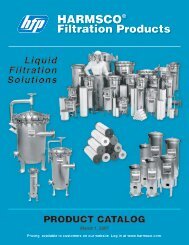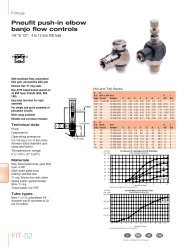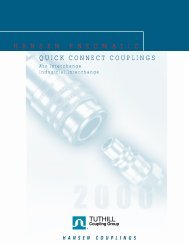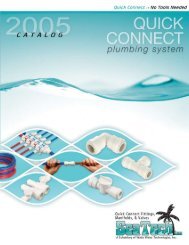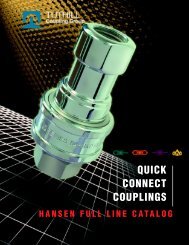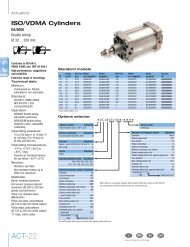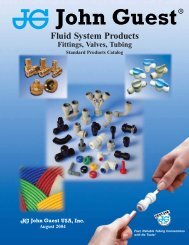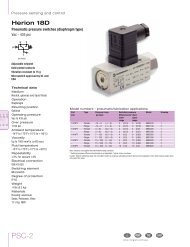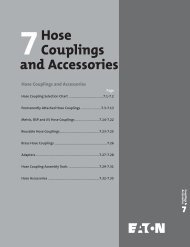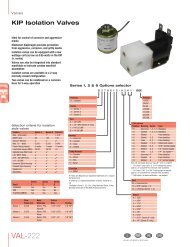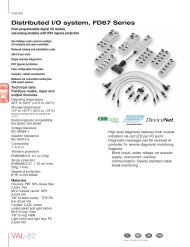FilmTec Technical Manual - Chester Paul Company
FilmTec Technical Manual - Chester Paul Company
FilmTec Technical Manual - Chester Paul Company
You also want an ePaper? Increase the reach of your titles
YUMPU automatically turns print PDFs into web optimized ePapers that Google loves.
2.6.5 DBNPADBNPA (2,2, dibromo-3-nitrilo-proprionamide) has the following characteristics:• Compatible with the membrane• Fast acting• Cost effective• Acceptable transportation, storage, stability and handling characteristics• Broad spectrum control (e.g., planktonic and sessile organisms); algae control is seasonal and situational• BiodegradableThere are several DBNPA-based products available. For more information about DBNPA or to find a supplier, refer to theDow Biocides website at www.dowbiocides.com.In RO systems operating with biologically active feed water, a biofilm can appear within 3–5 days after inoculation with viableorganisms. Consequently, the most common frequency of sanitization is every 3–5 days during peak biological activity(summer) and about every 7 days during low biological activity (winter). The optimal frequency for sanitization will be sitespecificand must be determined by the operating characteristics of the RO system.The standard method to apply DBNPA is slug (intermittent) dosing. The amount of DBNPA used depends on the severity ofthe biological fouling. With a water less prone to biological fouling, using 10–30 mg/L of the active ingredient for 30 minutesto 3 hours every 5 days can be effective. Because DBNPA is deactivated by reducing agents (such as sodium bisulfite usedfor chlorine removal), a higher concentration of DBNPA will be required if there is residual reducing agent in the feed water.The concentration of DBNPA should be increased by 1 ppm of active ingredient for every ppm of residual reducing agent inthe RO feed water. To remove the dead biofilm, an alkaline cleaning is also recommended. (see Section 6.9.6, Biofouling)Biocides, their degradation products, and other ingredients in their formulations are not always completely rejected by ROmembranes. For this reason, during slug dosing, it may be necessary to discharge the permeate during biocide injectionbecause the permeate may contain slightly elevated levels of organics.Note that although DBNPA is nonoxidizing, it does give an ORP response in approximately the 400 mV range atconcentrations between 0.5 and 3 mg/l. For comparison, chlorine and bromine give a response in the 700 mV range at 1mg/l, which increases with increasing concentration. This increase in ORP is normal when adding DBNPA and it isrecommended the ORP set-point is by-passed during DBNPA addition.2.6.6 Combined ChlorineSanitization with agents containing combined chlorine is generally not recommended. This includes such compounds aschloramine, chloramine-T, and N-chloroisocyanurate. FILMTEC RO and NF membranes are resistant to lowconcentrations of mild chlorinating agents. Their effectiveness as disinfectants at low concentrations, however, is limited.These compounds can also slowly damage the membrane because they are in equilibrium with small amounts of freechlorine.For chloramine, the tolerance of the FT30 membrane is 300,000 ppm-h, which implies that dechlorination is not required.Since chloramines are formed by adding ammonia to chlorine, however, it is possible that free chlorine will be present. Sincethis free chlorine can be damaging to the membrane, dechlorination should still be considered. Moreover, iron catalyzesmembrane oxidation by chloramine. Thus care must be taken when chloramine is used as a sanitization agent.The recommendation is to not use chlorine dioxide with FILMTEC membranes. FILMTEC membranes have shown somecompatibility with pure chlorine dioxide. Chlorine dioxide that is generated on-site from chlorine and sodium chlorate,however, is always contaminated with free chlorine that attacks the membrane.Page 61 of 180 ® Trademark of The Dow Chemical <strong>Company</strong> ("Dow") or an affiliated company of Dow Form No. 609-00071



